Viral photos are going around showing a Michigan crash involving a modern Kia Rio and a 1973 Chrysler New Yorker. The Rio is completely smashed up, while the New Yorker looks almost perfectly fine. “They don’t make ’em like they used to” is what a police officer allegedly told the classic car driver. But is that Chrysler New Yorker’s bumper really that strong and is that 2015-ish Kia’s front-end really that flimsy? Here’s the real story.
The full story comes to us from the owner of the Chrysler New Yorker, Markku Jaakkola, who runs the Detroit’s Unforgotten Wheels Instagram page and blog.
It all began with his post on Facebook, shown below:
“So, how’s your day going ? I was just driving home from company picnic…Cop said ‘they don’t make them like they used to..’ when he saw the ‘damage’ on my 1973 Chrysler New Yorker: the license plate fell off,” reads the post, which includes the photos of the battered Kia and remarkably intact Chrysler.
Pretty much the entire internet shared this post, with many rightly criticizing modern cars for having useless bumpers, and many others rightly criticizing old cars for having poor crash performance (i.e. a lack of a crumple zone, and therefore a high impulse, which is dangerous for humans and in this case would cause severe whiplash).
Jaakkola posted a follow-up:
“Couple additional photos of today’s accident with my 1973 Chrysler New Yorker (my license plate fell off),” the follow-up reads, showing the mangled license plate, but the otherwise beautiful rear bumper.
But is the Chrysler New Yorker — which shares its C-Body platform with the Demolition Derby champion, the Chrysler Imperial — really that tough so that its rear bumper could demolish the entire front end of a Kia Rio without sustaining a scratch? The answer is no.
Jaakkola, a car-loving Finn who lives in metro Detroit, chatted with me over the phone about what happened.
“I was coming back from a company picnic; I took Dequindre [road] northbound, and I was driving north, and I saw this girl [in the Kia] coming from the middle lane towards me… and the next thing I know I felt a huge bump in the rear,” he told me, “then I saw a Chevy pickup truck kinda like bouncing around next to me on the right side, so after everything stopped I went outside kinda anxious to see what I was gonna find behind me, because it was completely crashed, but the girl was OK.”

“Then the Chevy pickup guy came over there, and he said [the Kia driver] hit him while he was driving the same direction that I was,” Markku explained, saying the Kia driver was trying to turn left behind him in the old Chrysler. “The truck guy, he spun around a couple times, hit a Ford Fusion that was maybe three or four cars in front of me, then he drove his car to a driveway that was on the right side of the street.”
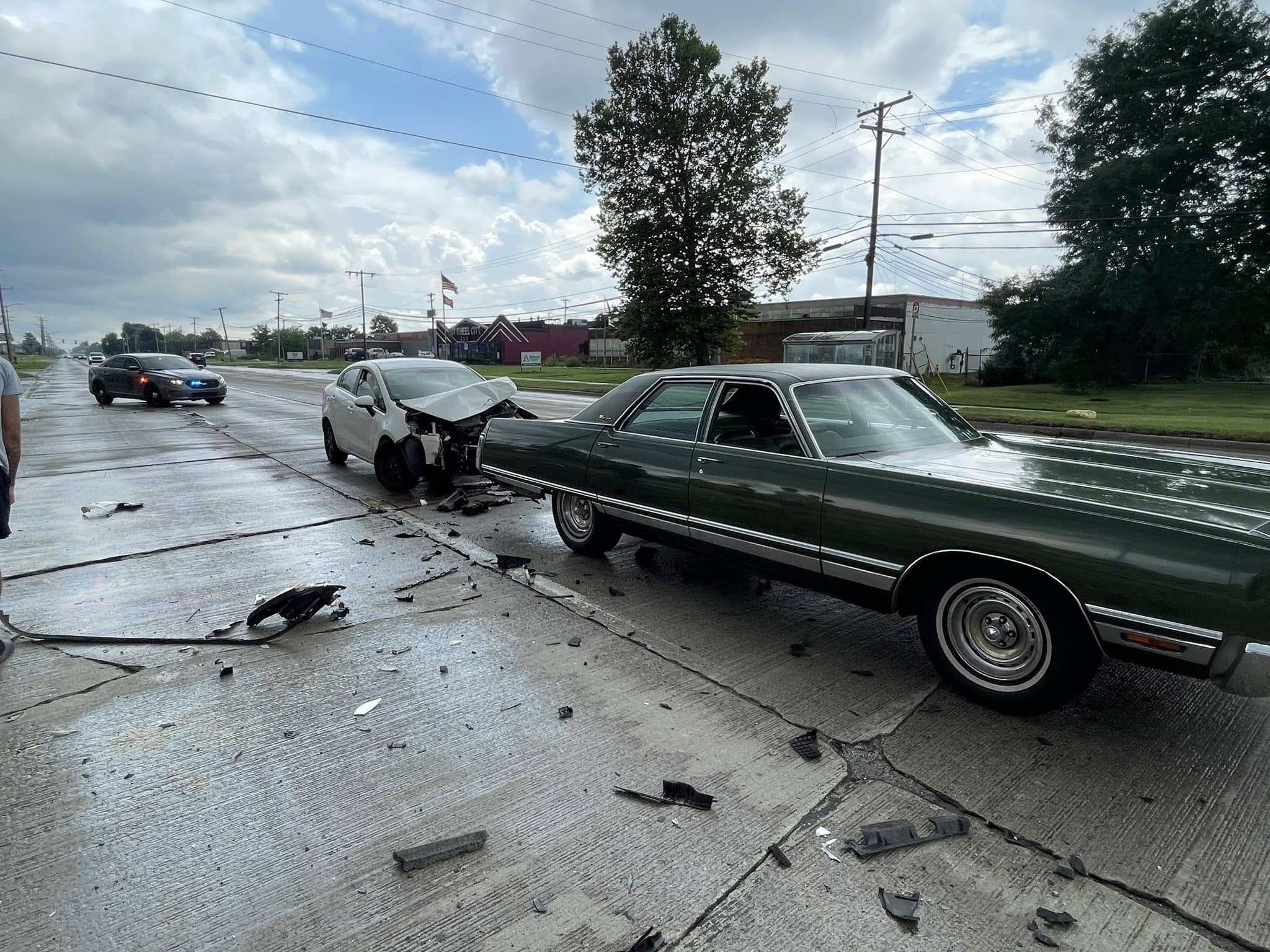
This left just Markku’s 1973 Chrysler New Yorker and the Kia Rio in the street, so that’s when Markku took the photo. “I would think the truck hit her on the left side [front], and she hit me on her car’s right side [front],” Markku went on.
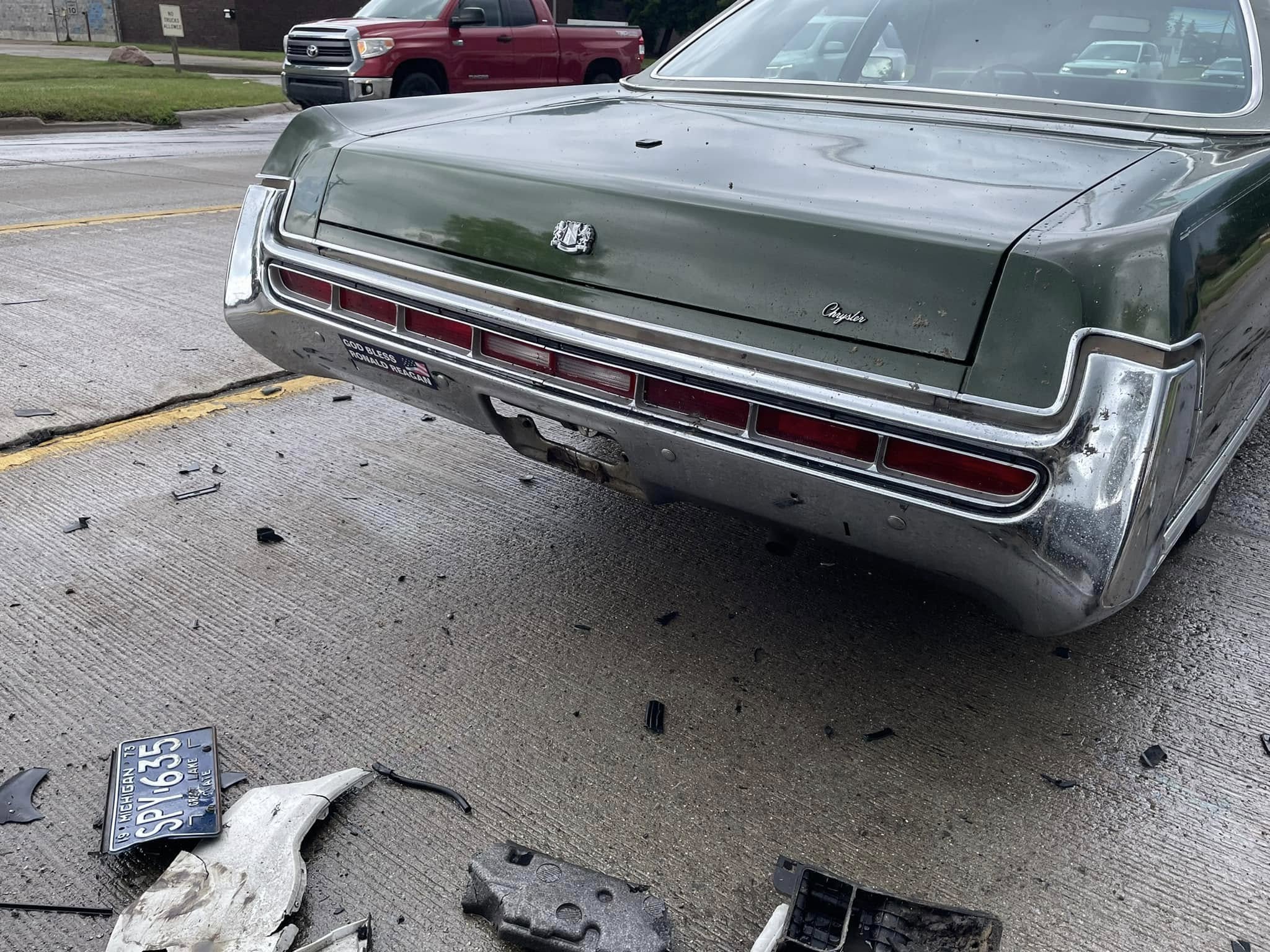
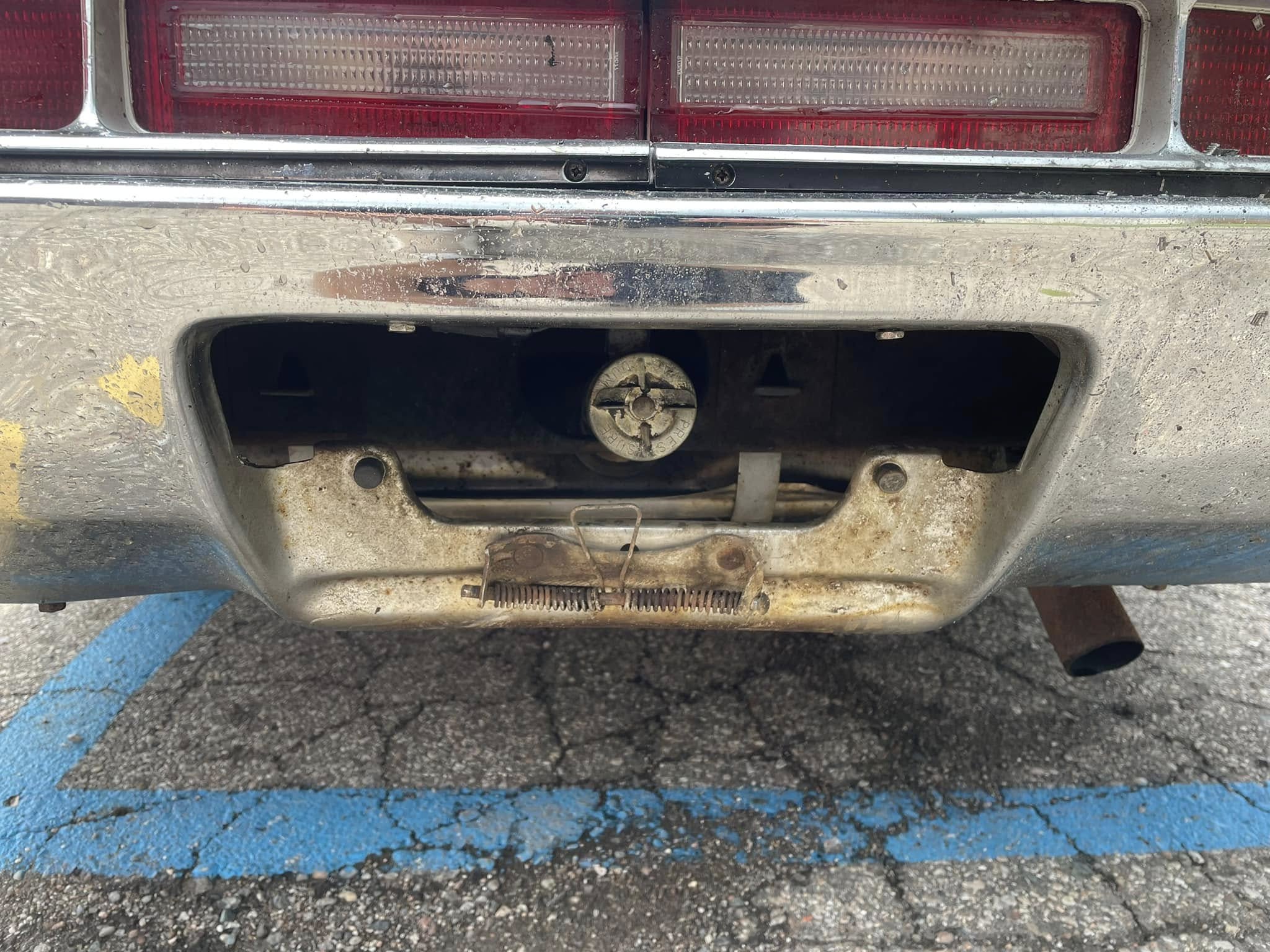

“I just posted it [to Facebook] like, so here’s my day, how’s your day going. I wasn’t thinking anything else about it,” he told me over the phone. “People are starting to fight over if the new cars are better than the old ones or vice versa…People are claiming that I never was really part of the collision.”

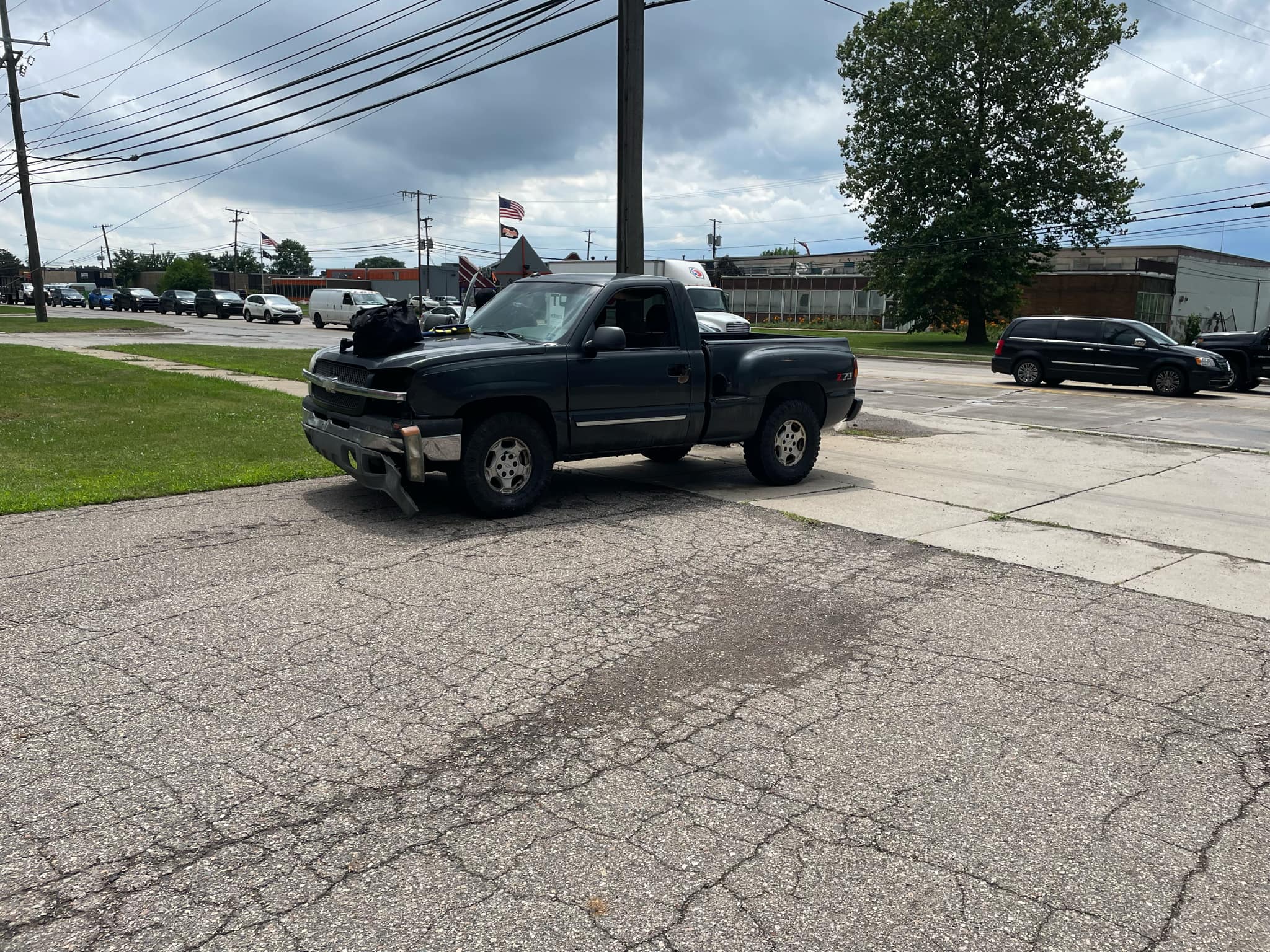
When I asked Markku why he thought his post resonated with so many people, he replied: “I think because it’s kinda unique that an old car would be in a crash, especially somebody taking a photo of it…basically nothigng happened…because there are a lot of people interested in classic cars…especially a lot of older people.”
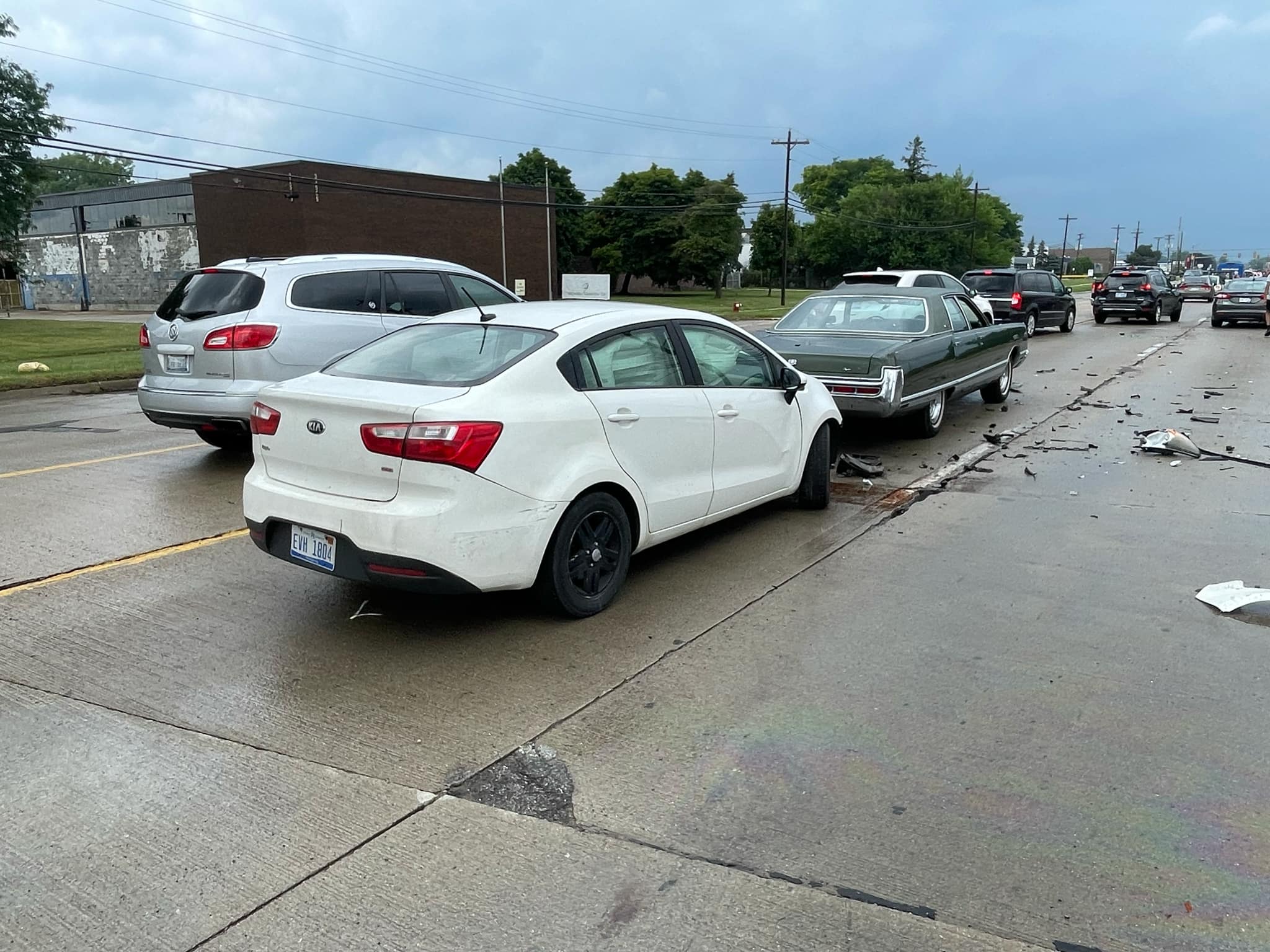
Markku’s post has received quite a bit of criticism from skeptics who understandably believed Markku was implying only his car and the Kia were involved in the crash, with one Reddit post titled “Chrysler guy is lying” garnering over 36,000 comments as of this writing.
When pressed about whether he understood why his initial post made many think it was just his car and the Kia involved in the crash, he told me yes. “Yeah I get that, and I didn’t really put any comments on what actually happened, any details, so it’s easy to assume that the Kia hit me…I didn’t really include any details.”

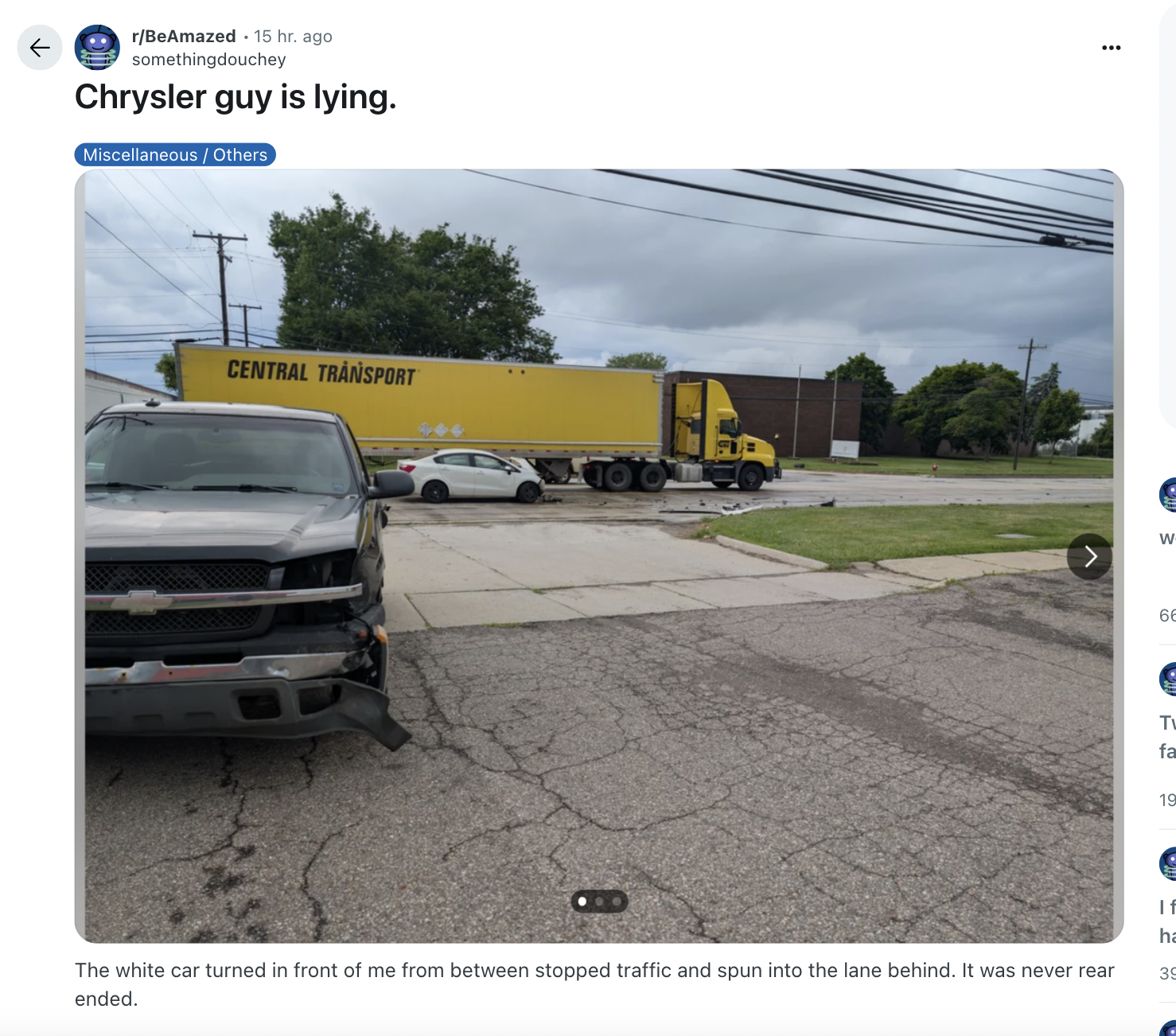
In response to folks who are claiming he backed up to the crashed kia, Markku texted me: “I’d like to know if they really think that I would back up my car there while police is parked behind us and intervene on his investigation to get a photo for social media.”
Markku finished by telling me his thoughts on the old car vs. new car-in-a-crash thing. “Of course [the old car is] made out of thicker steel, but if you’re going to be in a high-speed accident I’d rather be in a new car.”

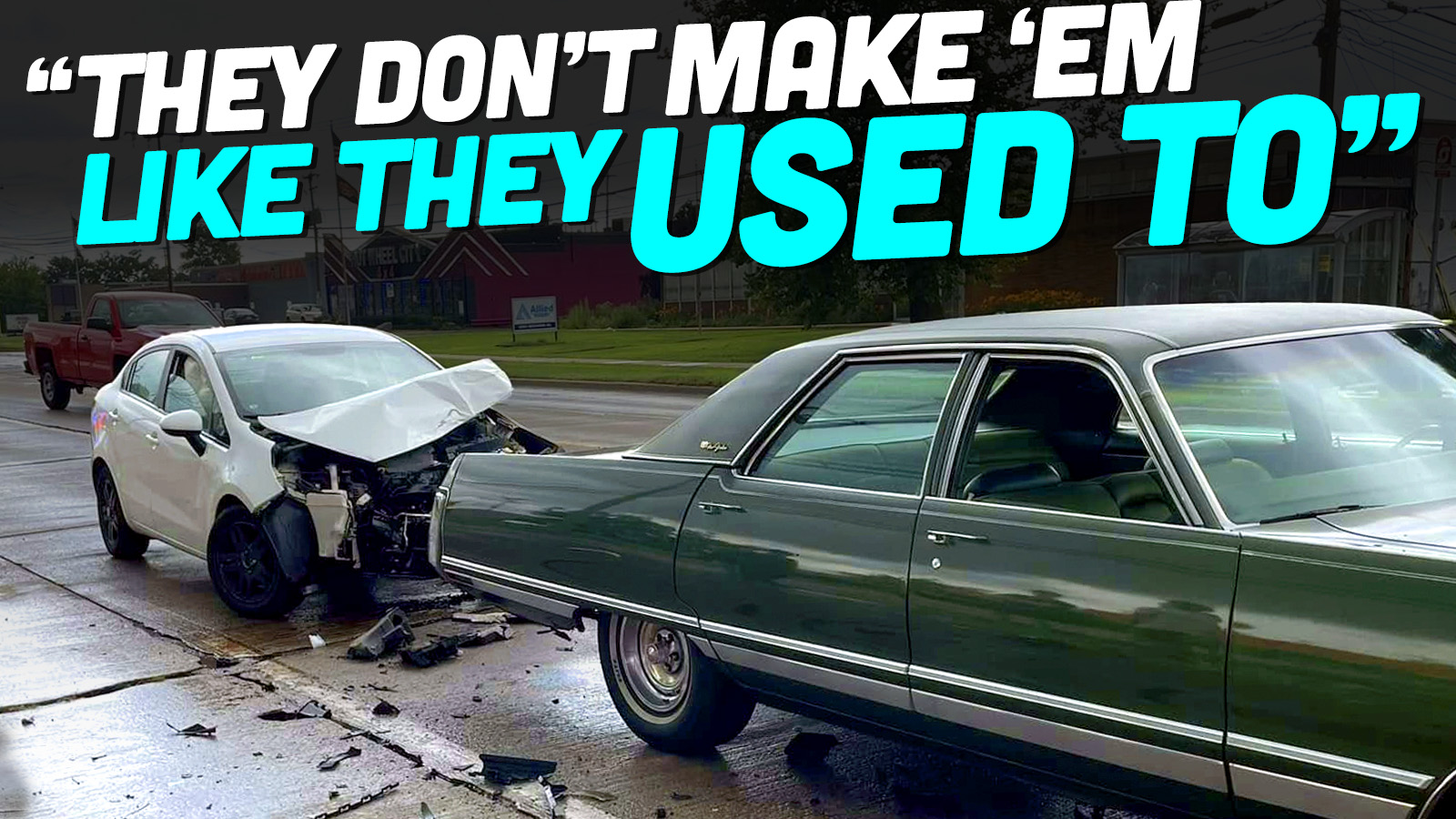




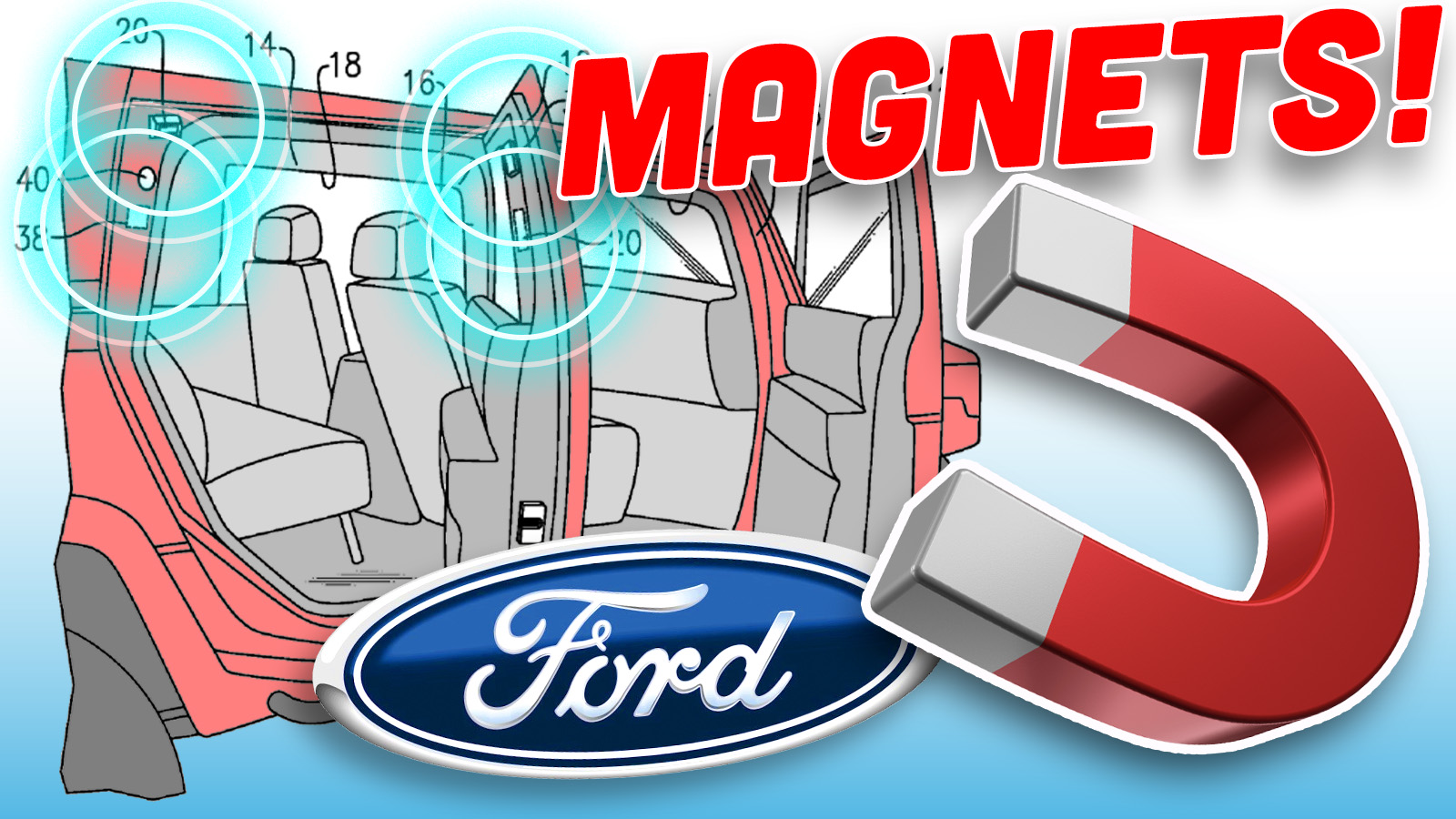
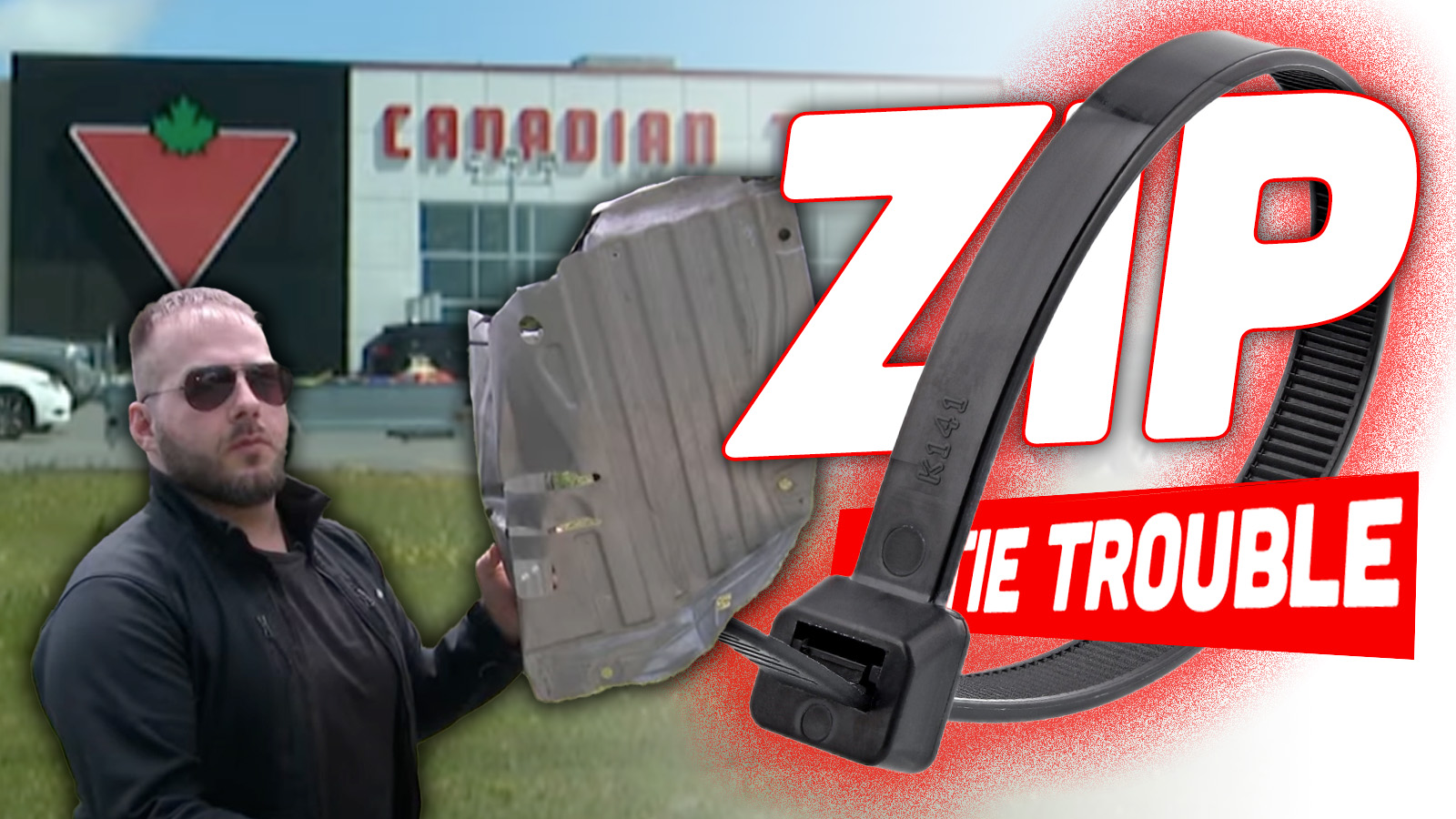
Seems pretty typical of a 70s boat vs just about any car from last 30 or so years maybe longer. I can remember an ancient relative had a 70 Buick my dad was basically responsible for maintaining. In 95 some girl just bought a brand new Nissian Altima and ran right into it. The brand new just off the lot Altima was totaled that old boat didn’t have any real damage just some Altima that needed to be scraped off. But they same insurance company that ended suing it’s self.
“Markku Jaakkola”
I sure wouldn’t want to ask him to open that trunk. I might get a late-night visit tonight..
The only 70s cars I’d feel safe in are a Volvo or a Mercedes. Both companies were leaders in crash testing, unlike the Big Three, which were dragged kicking and screaming into safe body structures. SAAB, BMW, and VW would get an honorable mention.
This is always worth revisiting.
When I was a teenage (1980s) we flew to Sarasota, Florida for Christmas. My grandfather had left his mid-‘60s Lincoln Continental sedan at the airport for us. Less than a mile from the airport we were the middle car in a three-car accident.
We were stopped at a light when my dad saw a big ‘70s Ford LTD coming up behind us at 40mph. “Look out!” he yelled, and took his foot of the brake preparing to steer onto the berm.
At the last second, the LTD driver hit the brakes, causing the nose of the LTD to dive into and under the rear of the Lincoln. We were shoved forward into a small car (Escort?) in front of us. My younger brother had turned around to look out the rear window and had a nice chrome trim print on his face, but no real damage. Mom had a bit of whiplash, but everyone else in all three cars was fine.
The cars? Well…
The LTD’s front end was smeared back over the top of the engine.
The rear of the Escort was crumpled like beer can. The guy was pissed – he’d just picked the car up from the body shop following another accident at the same intersection.
The Continental… had a slight wrinkle in one rear fender. We drove it away and kept driving it for the next week. Later we found that the unibody was tweaked slightly. Grandpa ended up trading it off for another Continental. And he never loaned us a car again.
So, while I know that modern cars are much better designed for accidents and I’ve seen images of old cars absolutely destroyed in impacts… I could also believe that Chrysler took a hit without showing much damage.
Glad everyone was okay.
A friend was recently the 4th car in a chain reaction accident. It totalled his car. Most of the damage was from him swerving up an embankment to avoid a direct hit though he still got clipped. Of course, the responsibility for the whole thing was attributed to the first car swerving to avoid a small rock and rolling onto its roof! Amazingly, no injuries.
Just my mind wondering. Nothing to do with the article here but why don’t we see articles or comments about the way car design has changed. New cars are designed to protect the meatbags not the car. Old design was to protect the car. This is why a new car design for safety gets totaled after an accident that if it was a pedestrian they could walk away from. Bad decisions trying to make things safer for a pedestrian but makes visibility worse and actually causes more accidents.
Imo this is actually great lesson in misinformation and needing to wait for context instead of jumping to conclusions the moment something happens. I’ve seen posts of the viral rear end and ground license plate pictures floating around with the usual modern car gripes (hur dur muh plastic, they dun makum like they used to) and now I can use this article to dunk on people that need a physics lesson I mean provide info as to how this event actually happened 🙂
As per the bumper sticker;
“Of course old cars are safe, how do you think they got to be old cars?”
As with many bumper stickers, not actually true.
Prove it though I agree
Survivorship bias.
It’s remarkable how many of my friends didn’t make it into this century actually.
Not necessarily severe whiplash due to the difference in mass involved, and the fact that effectively the OTHER car was the barge’s crumple zone. But if he had been hit by a Peterbilt, oh, yeah, bad juju.
For an extreme example, I was driving a 40ft coach carrying the NIU football team that was rear-ended by a Datsun. I didn’t feel a thing. I only knew something happened by the big cloud of steam in my mirrors.Scratched up the rubber on the bus bumpers pretty badly. The Datsun looked worse than this KIA, but the guy driving it was OK.
Some people just love attention, even if they need to lie to get it, even if they get caught in a lie, they still love it.
I’ll never understand this mentality.
This does remind me of the time a lady in a ‘73 Torino hit my ‘72 Corolla. Her bumper guard fell off, while my tin can Toyota needed a fair amount of body work. The only bonus was I found a guy to fix it for less than the estimate insuance paid on, so that I got new tires in the deal.
But I was driving a 1964 Ford Maverick car and another driver next to me was driving a Chevy Nova around the same vintage. Her lane merged into mine she thinks that means she is good to go. She merged into my car both cars are lifted up in the attempted merge. We both stop I educated her on traffic laws we look at are vehicles not a scratch.
First thing I thought was that the Kia had to have hit another car then spun behind the Chrysler, which it sounds like is exactly what happened. People need top put their thinking caps on. I believe that is a Kia Rio which weighs around 2500 lbs and based on the damage I assume it was doing around 30+mph. Simple physics will tell you that a chrome bumper cannot withstand a 30+mph crash with a 2,500 lb object. I was in my teens when the Chrysler was a new car and I can tell you from personal experience that bumping into a pole at 10 mph will put a good dent in a chrome bumper.
That ‘73 Chrysler didn’t have a 5 MPH bumper, either. It would have pushed the bumper into the body.
TBH that Chrysler was the same as the block of cement that the DOT USED
Strictly speaking they don’t make them like they used to, will any of those KIAs be driving around in 2067?
I was slightly taken aback that 2067 is as far into the future as 1973 into the past.
Then I realized you’re mistaken and that it’s actually 2077.
Yikes.
I don’t recall seeing a KIA in Cyberpunk.
I mean, I think the various offerings in Shitbox Showdown can at least point to the possibility.
Sure, if anyone cares enough to restore and preserve them.
With enough connecting rods and small electronics work I’m sure it has a fighting chance.
The real question is “Will Chrysler be around in 2067? Or even 2027?”
Probably about as many Chrysler New Yorkers from the 70’s that are still alive today. You do realize a huge amount of cars from the 70’s were in the scrap yard by 1990 because they were hideously unreliable and aged incredibly poorly, right? That 1973 Chrysler was well kept and loved. A well kept and loved Kia Rio will probably live even longer. I admit you’re less likely to find someone willing to love and care for a Kia Rio, but still. 70’s cars being alive now have very little to do with their build quality and a lot to do with owners keeping them alive.
TBF, those KIA’s are abominable shitboxes. Had one as a rental and I was shocked it could pass crash testing looking at the minimalist structure. Must be all in the airbags. I will credit KIA for making it well-balanced, though—it was a POS in every aspect. Snark aside, in a low speed parking lot-type biff, I’d take the old car, anything faster than that, I want something new as I’d rather the car dissipate more of the energy before it gets to me. Just maybe not a Rio.
In 1970, my Mom traded in her Corvair to buy a new VW Beetle. The Corvair’s floor was so rusted that she said you could lift up the floor mat and see the road. In just a few years (<10) that had happened, in Kentucky… they don’t make them like they used to.
If he’d been hit by another Yank Tank, this story would be very different. He should be glad the Kia crumpled as designed and absorbed so much of the impact.
Right. All old cars are really solid, except that they are like a marshmallow precisely where you need the most structural integrity: the cabin. You know, where humans sit?
All these “old cars were safer” is so bullshit. I own a 70’s car. I know I’d die a horrible death if I ever got into an accident with it.
I figure the seatbelts in my Spitfire exist mainly to make the coroner’s job easier by keeping the body mostly in one place.
I really want my old Midget back, but I am not as brave as you on American roads.
Meh, either one is FAR safer than a motorcycle or bicycle. And I only drive it under ideal conditions.
Exactly what my buddy told me when we drove to Hoover dam in my Midget.
The only little old roadster I’ve sat in was an MGA…yikes. The few seconds it took me to pop it into and back out of neutral (was a random person’s car I was pushing under their carport when it began raining) was enough for me, it was just a tad too small for my liking.
Of course, I feel the same way in a Miata, I don’t fits so I don’t sits.
A Spitfire is ludicrously roomier than a Miata. When you leave out all the modern convenience and safety features, even a 4/5ths size car has plenty of room inside. I had to get rid of my Fiata because driving it for more than a half hour was torture, but I can drive my Spitfire all day in comfort. I don’t even have to put the seat back all the way, there is more cargo space behind the seats than an M/Fiata has period, and the trunk is bigger too.
But I do prefer a smaller car in general, I see no need to rattle around inside some gigantic barge.
Did you even read the article? The damage to the Kia isn’t from hitting the Chrysler at all, it hit another vehicle first then spun into the Chrysler basically grazing it. It was already crumpled when it basically tapped the Chrysler.
In my mind, the phrase ‘they don’t make ’em like they used to’ is more applicable to furniture and maybe houses. Cars, though? I wouldn’t want to be caught dead in one.
I lived in an old house built probably around the great depression era. The entire walls were WOOD. Like hard wood tat had plaster or drywall on top. i only found out after trying to mount a TV i could not believe it!! easiest tv install ever just drill with wood screws directly into the wall!
I live in a 1930’s house as well.
Be careful with that. It’s not solid wood, it’s plaster and lath. Thin horizontal strips of wood (lath) nailed against the studs an eighth of an inch or so apart, with plaster applied on top.
Don’t trust century old 1/4″ thick wood strips to carry your TV. It is best to hang heavy objects to studs. Don’t bother using a studfinder, it won’t work. Apparently a trick you can use is running a heavy magnet against the wall. It will stick where the lath is nailed to the studs.
I was living in NYC’s east village and one night some motorcycles went by and the entire horsehair and plaster on lath ceiling of the railroad apartment peeled off. It took about 30 seconds and was quite spectacular.
My girlfriend had hung a Chinese lantern from the ceiling, and a famous avant-garde composer lived upstairs and had been working on a commission for a marching band for the previous couple months, but I’m pretty sure that living across the street from the Hells Angels clubhouse was a contributing factor as well.
Anyway, plaster and lath is really resilient right up until it isn’t. It was built before the civil war, so it had a good run.
Actually all the stuff that had crawled between the ceiling and the floor upstairs and died over 120 years was the icky part.
Holy shit, what a nightmare. But a hell of a story to tell, that’s for sure.
Btw I live by a stadium, so my house also gets its fair share of vibration. New fear unlocked, thanks.
i think i might have got lucky and hit a stud anyway. it was one of the ancient 1080p flat screens that weighed a million pounds. it stayed up with no issues for 4 years before i moved. I got it as a freebie from some non profit that upgraded to a new one and needed me to take down the old tv off the wall. free tv and a free mount!
The best stud finders are the simple stupid ones that are a little magnet attached to a pivot. Slide it around the wall and it’ll grab onto the nail. Center it in the X direction and you have your stud.
MY 200yo house is still here, but that doesn’t mean the old parts aren’t complete and utter thrown together crap. Because they are. And then 200+ years of bandaids on top. Fun.
In my defense, I did say maybe. 🙂
I do think there was probably a peak of house craftsmanship – maybe the 50s? More modern, but without the current spate of builder-grade crap?
But ultimately, entropy always wins absent constant attention.
Imo 80s builds are the sweet spot. New enough to avoid asbestos and have modern electrical, but still before developers realized they could get away with murder.
For sure my 1985-built house in FL is built massively better than my ancient pile in ME.
But the house I have having built right now will be better still. Because it’s not being built by shitty production builders, and will be built out of steel, not cardboard and dreams (the only wood in it will be the interior doors and millwork). But on the other hand, I am paying the best part of a half-million for a 1400sq/ft 2bd/2ba house with laminate countertops. At least 40% more than a larger shittily built house would cost. That would have granite so that SWMBO can impress her girlfriends. 🙂
I think 40% more is reasonable. Whenever I spend time in a concrete home with my family overseas, I enjoy not having to walk like a burglar while they are asleep. That alone makes it worth it. Not to mention how common I imagine termites are in FL.
You can’t really build a wooden house in my part of FL today and meet code. A concrete block house to FL standards is already 30-40% more than a wooden house up north (and they are still built like dogshit by the production builders, even if it’s dogshit that can take a hurricane). My new house is 40% more than THAT. And worth it because it’s rated for another 80+mph of wind, and will cost a fraction as much to cool, while actually being straight, plumb, and level.
But most people won’t, or can’t, afford to do what I am doing. For one, there is basically no way it’s going to appraise for what it is going to cost me to build, but luckily, I don’t need to mortgage it for that much. That is very much not the norm.
Hurricanes are a non-issue where I live (Ontario, Canada), so that was an interesting read.
The differential in wind ratings between concrete block and steel alone is greater than the maximum wind speed of the only hurricane that ever hit here. It was a category 1 back in 1954.
Anyway congrats on the new house! Sounds like it’s well engineered while being relatively modest, which is how I’d hope I’d do it if I had the means.
Overall, I love living here, but the storms do suck. But they suck less than snow all winter in Maine, LOL.
It gets expensive FAST to build to these standards. My 16Ft garage door and 8x8ft lanai sliding glass door together are about the cost of a reasonably priced new car.
Pre WWII is the gold standard for high end apartment buildings and houses in NYC. Materials and skilled trades got permanently changed by the war. I don’t think anybody is building with 4 foot thick brick walls, and riveted Ibeams anymore.
Really old houses not built by rich people, sort of depend on how tall you are. If you’re 6 foot tall, you’ll be banging your head of all the time in 200 year-old houses.
Post World War II there was a huge amount of housing built very fast of varying qualities.
There’s also a lot of nice mid-century modern housing designed by real architects, sometimes built by contractors that knew what they were doing, and sometimes built by contractors that didn’t have a fucking clue, and it’s kind of hard to tell the difference until you look closely.
All wiring and plumbing before 1980 sucks, for extra fun in old New York buildings the gas lines for the lighting sometimes are still hooked up, and the gas pipes are everywhere, so that if you accidentally cut into it, boom goes the building.
Anything more than 20 years old depends on maintenance, but it’s never go to be better than it was when it was new.
Oh, in earthquake country, what will and will not survive an earthquake is completely counterintuitive.
I am getting ready to sell a house in California and move back to New York and I’m not really looking forward to the whole process.
If only I had some Irish grandparents, I’d be all set, but my family left in the late 17th century.
I own a house that is the best part of 225 years old. I only potentially bang my head going up the stairs (I never have, but my friends are less aware of it). 7′ ceilings are adequate if you aren’t a pro basketball player.
As you say – the problem with pre-war is that while the structure and millwork can be lovely, the systems SUCK. I would rather have a plainer home that has functional plumbing, heating, and electrical.
My house is absolutely better than it was new, considering it had no electricity, no central heating, no plumbing and an outhouse when it was built (and it was ~600sq/ft originally). But it’s still basically a heap of crap, being originally a built as cheaply-as-possible millworker’s cottage that was added on to over the years. But in that sense, it’s a bit special because despite the area I live in originally having had HUNDREDS of them, it is one of very few survivors.
I’d say the sweet spot is 50’s – 70’s.
Those houses are well-constructed, the tilework would have been done with mud, the Formica was indestructable, the attics were still hand-framed, cabinetry was stick-built on site w/ plywood and solid wood. If it was stucco – it was real stucco over wire lath.
The only weak spots were the single-glazed windows – which on ranches were aluminum-framed – and the garage doors, which were solid wood and plywood panels – but would have been single panels which sagged over time even with the steel tension bar reinforcements.
Standard Boomer meme – they’ll believe essentially anything if you pair it with “they don’t make em like they used to”
Whole bunch of us here, I would think.
Generally, with the exception of tomatoes that is a good thing.
Us boomers are why there is so much crappy 70 year old slapped together cheaply built yet very expensive housing, plus so much even worse 40 year old crap.
On behalf of my cohort I apologize, but between you and me, a lot of them are jerks and I thought that stuff was crap when it was new.
Of course there was the time our 1967 VW bug was rear ended by a 1967 Camaro at a stop light (guy wasn’t paying attention) and it destroyed the rear of the bug (we got a Ford LTD rental) and there was a paint scratch on the lower and upper front grill surround on the Camaro.
One summer weekend a few decades ago, I was in stop/go traffic southbound on the Hampton Roads Bay Bridge Tunnel in my 1971 Volvo 144S.
At one point I thought traffic was picking up – then the Firebird in front came to a very sudden dead stop.
I had no problem braking in time.
The new Renault Alliance behind me didn’t fare so well.
After the crash I got out and walked back to check on things. Her front bumper had clearly slid beneath my back bumper, and my bumper demolished everything above hers. Grille and lights – in shards on the ground. Fenders and hood – bent and twisted. Internal fluids – Now external fluids.
My tailpipe was bent down a little.
I didn’t have insurance – but I knew it was her thing since she rear-ended me and there were no human injuries. So I didn’t stick around.
“Sorry – Good Luck – Bye!”
Later that week Midas bent my tailpipe up again.
No charge.
I used to be an estimator and asst man. in a body shop in a foreign car dealership in the late 70s. I used to make so much commission every time a TR7 or 8 would hit the rear end of an American car, especially at night. It would ride under and rip out the headlights (light, bucket, and panel) and strip the actuator motor, and rip them out of the core support panel, which sometimes also needed to be replaced. Good times…
HRBT! I live near there and am always surprised to see it mentioned. I avoid going through them as much as possible though because it’s always stop and go through there! Glad you fared so well in the wreck!
LOL – had the same thing happen with my ’82 245 Turbo. Doesn’t end well when the bumper of the car hitting you goes under the battering ram that Volvo used for bumpers in those days. And particularly with the wagons, the rear is NOT a crumple zone since they were designed to have those kid seats back there.
I’m surprised and delighted that the slimmer 140 bumper held up as well as the 240 for you! Good job, Volvo!
I was parked on the street in Brooklyn, one spot in from the corner and there was some sort police car chase that ended in the police trying to to cut someone off but instead hitting the car in the corner parking spot. The police car was obviously totaled, the car on the corner had huge damage in the rear and the front was pretty badly damaged where it went under the bumper of my 1986 Volvo 740 wagon. The hatchback in front of me had some damage to its bumper which was kind of mangled, and the hatch was shoved in. Absolutely no damage to the Volvo.
Someone from the city came to take pictures, NYC doesn’t carry insurance for that sort of thing thing so he was the equivalent of their insurance adjuster. He was kind of impressed, asked me if there was any damage and I said no, that’s why I never park in the first spot on the block. Still, those big old bumpers worked.
It sometimes feels like big ol’ boats were designed for old people who probably shouldn’t still have their license but they’re just going to the grocery store and church so it’s fine.
Those things can crush so many shopping carts without incident. They can handle every single low-speed tap you can throw at them. You’re not even going to get a scratch when you boop into the telephone pole outside of church because you weren’t paying attention.
But high speed crashes… Grandpa shouldn’t be going that fast anyway. And he’s had a good run.
Back in 80s I had a 77 Maverick (one with the huge chrome bumpers). On way home from work, a guy in a Chevette tried to dart across 5 lanes in the rain. Didn’t make it. I nailed him with my left front bumper and sent him back to where he came from. His car demolished. I had a slight bend on my front bumper and small crease in fender. His insurance gave me a check for $1200. I paid $1200 for the car. Paid for next quarter’s tuition. Never bothered to fix.
Drove a 76 Maverick 4 door 6 cylinder through a flood. Like a trooper. Loved that car.
Nice time for the reminder that in every car accident, there are 3 collisions:
1. Car with an external object like another car.
2. Humans inside the car with the interior of the car.
3. Organs of each human with the inside of the body.
Older cars give the impression of doing ok in collision 1 (sometimes), but absolutely fail the humans in the car with collisions 2 and 3. Newer cars do a great job of 2 and 3 at the expense of 1. People who would say “don’t make them like they used to” need to stop living in the past.
My father is a retired first responder, and has seen first hand the difference between the two, and has described too many of them to me. It’s ghastly.
^^THIS^^
The one that has garnered a lot of attention lately is the collision between the brain and the inside of the skull. This extends to sports occurrences as well.
+1. I know someone who has had serious long-term problems as a result of two concussions in relatively close proximity to each other caused by car accidents (neither of which she was responsible for). Completely changed her life, and not in a good way.
I’ve been rear ended three times. First time was in a 1970 Mercedes 240 D, smashed the crap out of the back, they replaced everything back of the trunk hinges. No injury at all. My mom was driving. Don’t remember anything about the insurance.
Second time I got rear-ended by a taxi cab in New York City driving a VW Dasher. The rear driver side as hit hard enough that the front of the rear tire was pressed against body and the rear beam axle was displaced. The cab companies insurance adjuster came looked at it gave me a check for more than I had paid for the car plus an extra thousand because it had a “high end stereo” installed which was actually a couple speakers in cardboard boxes wrapped with upholstery. I had it towed to a taxi shop on the west side highway that had a frame straightening machine, paid them $300 and they pulled it out until the rear axle was in the right spot and I drove it for another 70,000 miles. No injury whatsoever.
I actually lived off of that for a year in a converted milk shed on the Astor estate in the Hudson valley.
A few years later I had a 1962 Ford Galaxy. I was stopped at a red light and a truck rear ended me hard enough to send me about 70 feet. Bent the seat back, but on the outside there was no visible damage whatsoever. My neck has been hurting continuously for the last 45 years.
Except for my sister’s 23 window VW bus, I won’t ride in any car without head rests. Her’s I make an exception for since it would probably be a fairly quick death
“don’t make them like they used to” is technically true and absolutely a good thing.
My “unreliable” newish Audi will probably get me 200,000 miles, can cruise in quiet comfort at 80mph all day, and if god forbid we are in a substantial crash with it the car may be totaled but the odds are good that my wife and I will be basically fine.
The version of this I saw last night was “they don’t make em like they used to… because you were the crumple zone.”
My father used those exact words. Then described things I never want to see. *shudders*
Congratulations on COTD today! 🙂
My step dad owned a body shop up from the early 70’s until the early ’00’s . I worked for him for a couple of years and when anyone brought up the “they don’t make ’em like they used to” or “you can’t work on this new junk” tropes he’d always say he preferred working on newer stuff. Why? Less teeth/blood/etc left in ’em than there was in the good ol’ days.
My family had the more humble 1973 Newport version and while I agree there is no way it would avoid (and dispense) damage quite as dramatically as the photos it was a beast of a car.
There has been significant debate – even here at the Autopian – about what Chrysler was big as a whale and about to set sail to the love shack but I always assumed it was one of these. The only bigger vehicle in town was a 7th gen F-series Crew Cab long-bed.
“There has been significant debate…about what Chrysler was big as a whale and about to set sail “
In the video it was a 1966 300 Convertible.
Yeah but the ’66 was just not really big enough in my mind. It’s a cool looking car for the video and convertible is really the best way to get to the love shack though…
There’s always the 1969/’70 Newport and 300 Convertibles.
They were as big and whale-like as Chrysler was going to ever get.
I took my driver’s range test in a 1971 Plymouth Sport Suburban station wagon (named “Sherman”) and passed. I think those were bigger than the 225.
That’s definitely one of those which makes you wonder what the marketing team thought the word “sport” means.
Although looking in my Motor manual from 1972 I see the 383 4bl (that we had) was rated at 300hp and 410ftlbs, through a 727, to probably a 3.23 rear gear (we limited it to 65 or so on the highway due to high revs). It would scoot, that’s for sure. I remember remarking that the car shouldn’t already be going 70 in the neighborhood after being ‘brisk’ with the throttle one afternoon.
Because of emmissions and fuel costs I think they lost 100 hp from ’71 to ’73. Ours had the 400ci 2bl which I am pretty sure was putting out somewhere in the range of 170-190hp and about 300ftlbs.
I’m not sure what rear end it had but probably a bit taller than yours – it had no problem towing a decent sized inboard outboard speedboat from about the same era but the car really was a cruiser. It was way to easy to be floating along the highway and look down to see you were doing 80+.
Dad had a 73 Satellite Sebring Plus with the 400 2bbl, rated at 185hp net. It was still a quick car.
I don’t think anyone would describe the Newport as “quick” it was huge with soft suspension, especially at 25 years old, more of a yacht than a speedboat.
I just checked the stats against my A6 Allroad and despite being a full 3 feet longer and 5 inches wider the Newport actually weighed almost 300lbs less. The Allroad has 80% more hp from an engine with less than half the displacement though, which is nice.
In my mind it was the ’76 Town and Country my Aunt Betty had. When she went to a Ford Escort the owner of the gas station she always used told her he had to let a guy go.
Pre oil crisis cars were thirsty! I commuted to my minimum wage lifeguarding job 32 miles each way one summer with my 2 options being the ’73 Newport getting about 10mpg and a Suzuki GS250 getting about 65mpg. I usually chose the bike and probably doubled my income from fuel savings alone.
It’s “a 1954 Chrysler Crown Imperial.” – Mr. J. Torchinsky, 17 June, 2021
https://www.jalopnik.com/lets-figure-out-what-kind-of-chrysler-theyre-talking-ab-1847122630/